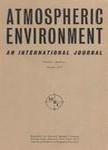版权所有:内蒙古大学图书馆 技术提供:维普资讯• 智图
内蒙古自治区呼和浩特市赛罕区大学西街235号 邮编: 010021

作者机构:Fukuoka Univ Fac Sci Dept Earth Syst Sci Fukuoka Japan Natl Inst Environm Studies Tsukuba Japan Fukuoka Univ Fukuoka Inst Atmospher Environm & Hlth Fukuoka Japan Hokkaido Univ Sapporo Japan
出 版 物:《ATMOSPHERIC ENVIRONMENT》 (大气环境)
年 卷 期:2022年第289卷
核心收录:
学科分类:0830[工学-环境科学与工程(可授工学、理学、农学学位)] 08[工学] 0706[理学-大气科学]
基 金:Fukuoka University Industry and Government Collaborative Research Organization of Fukuoka University
主 题:Aerosols NOx PM2.5 Black carbon Sea breeze Land breeze
摘 要:Simultaneous measurements of wind profiles and of atmospheric substances such as aerosols and reactive gases were conducted at Fukuoka University in the western urban area of Japan to elucidate relations between local circulation and variations of aerosols and gases. Spatial variations of wind speed and direction over the Fukuoka Plain were measured using Doppler LIDAR. Some atmospheric substances such as black carbon, organic carbon, CO, and NOx were found to have maxima in morning (07-11 JST) and evening (18-20 JST), when diurnal cycles of wind direction and speed were observed near the surface. Doppler LIDAR data indicated clearly that the diurnal cycles of wind profiles were associated with sea breezes and land breezes over the Fukuoka Plain. The diurnal variations of aerosols and gases might be attributed to local anthropogenic emissions such as vehicle exhaust from Fukuoka city and vessels in the Hakata Bay and the sea and land breeze cycles. Strengths of morning peaks and evening peaks showed clear seasonal changes, with stronger peaks during the colder seasons and weaker peaks during the warmer and hot months. Slopes related to BC, OC, NOx, and CO were found to have seasonal changes. These seasonal changes were associated with the presence of a surface inversion layer in colder seasons, efficient photochemical reactions in the summer, and changes of fuel emission factors.